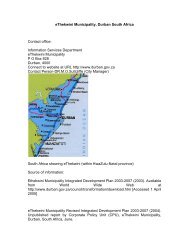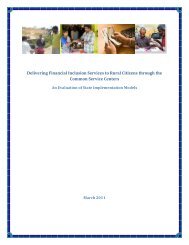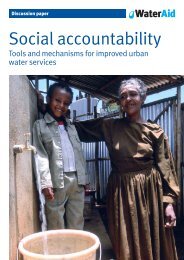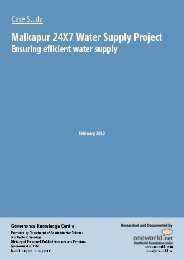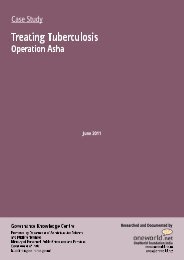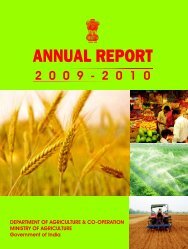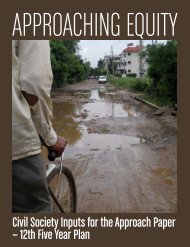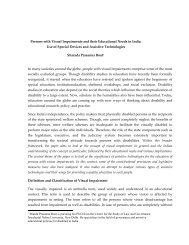Changing Framework of Local Governance and - Create
Changing Framework of Local Governance and - Create
Changing Framework of Local Governance and - Create
Create successful ePaper yourself
Turn your PDF publications into a flip-book with our unique Google optimized e-Paper software.
<strong>Changing</strong> <strong>Framework</strong> <strong>of</strong> <strong>Local</strong> <strong>Governance</strong> <strong>and</strong> Community Participation in Elementary Educationperform due to a lack <strong>of</strong> information or <strong>of</strong>ficial communication from the respective StateGovernments regarding the transfer <strong>of</strong> power to panchayats. The financial autonomy <strong>of</strong>panchayats is affected by tied grants from state <strong>and</strong> central government. Panchayats havebeen devolved very little power to generate their own funds. In the absence <strong>of</strong> adequate funds,the panchayats very <strong>of</strong>ten are not in a position to spend on education. They have to prioritisethe use <strong>of</strong> funds <strong>and</strong> in most cases education does not receive high priority (Mathew <strong>and</strong>Nambiar, 2002).In comparison to all these states, the situation in Kerala is significantly different <strong>and</strong> this hasbeen studied in detail (Isaac <strong>and</strong> Franke 2000; Mohanakumar, 2002; Mohanakumar, 2003;Lieten, 2002). A new panchayat act was enacted <strong>and</strong> a three-tier system <strong>of</strong> PRI came intoexistence in 1995. All the three tiers <strong>of</strong> the panchayat system were authorized to formulatelocal plans <strong>and</strong> to implement them with the active participation <strong>of</strong> people. Towards this,following the recommendations <strong>of</strong> the State Planning Board 40 percent <strong>of</strong> the State’s budgetwas given to the panchayat system to execute these locally generated development plans. Inaddition to this, as informed by Joy (2001), a Government Order issued in 1996 transferredsome significant powers related to primary education to the gram panchayat which includedthe supervision <strong>of</strong> routine functions <strong>of</strong> schools including the performance <strong>of</strong> teaching <strong>and</strong> nonteachingstaff; providing necessary direction to the Deputy Director <strong>of</strong> Education ifdisciplinary actions are needed against any <strong>of</strong> these staff; the gram panchayat is authorized tomonitor whether there are adequate staff in the school at the beginning <strong>of</strong> the academic year<strong>and</strong> it can provide necessary directions to the controlling <strong>of</strong>ficers to deploy staff either fromPublic Service Commission or through employment exchange; the gram panchayat is alsomade responsible for the supervision <strong>of</strong> the construction, repair <strong>and</strong> maintenance <strong>of</strong> schoolbuildings, the supply <strong>of</strong> midday meals to children <strong>and</strong> distribution <strong>of</strong> scholarships <strong>and</strong> grantsto students; as well as the provision <strong>of</strong> non-formal education etc. The gram panchayat c<strong>and</strong>ecide about remedial measures to minimise dropping out <strong>of</strong> children from school. In addition,is also authorised to supervise the workings <strong>of</strong> school complexes, conducting programmes likeaksharapulari 8 <strong>and</strong> other programmes implemented to improve quality. Similarly the districtpanchayat is authorized to supervise all the functions required to promote the quality <strong>of</strong>education in schools <strong>and</strong> is also responsible for the management <strong>of</strong> upper primary <strong>and</strong> highschools within the district.In the case <strong>of</strong> Karnataka, which had a record <strong>of</strong> better performance with respect to theimplementation <strong>of</strong> the PRI Act in the 1980s, the act was implemented in its diluted shape inthe 1990s (Issac <strong>and</strong> Franke, 2000). However, the state government decided to adopt somesignificant measures following recommendations from the Task Force on School Education 98 Aksharapulari is a programme implemented in 1993-94 as one <strong>of</strong> the pre people’s planning campaign efforts(Tharakan <strong>and</strong> Tendler, 2003). This programme was implemented by the District Councils that attempted to linkthe Total Literacy Campaign with schemes for quality improvement to help the children to improve their abilityin mathematics <strong>and</strong> science as well as to remove illiteracy. The programme targeted the children who werelagging behind others in their class (Ch<strong>and</strong>rasekhar, et al, 2001).9 “A Task Force appointed by the Karnataka Government in 2001 on quality improvement <strong>of</strong> elementaryeducation, recommended the setting up <strong>of</strong> School Development <strong>and</strong> Monitoring Committees (SDMC) for eachschool. The SDMC includes nine parent representatives elected from among the parents whose children arepresently studying in the school. The Task Force - headed by Dr. Raja Ramanna -suggested three-year tenure forthese SDMCs. Karnataka State has been one <strong>of</strong> the pioneers in setting up these SDMCs which replaced thevillage education committees.” (Vaijayanti, 2004:1)10




